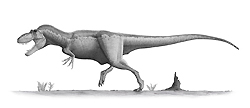The World That Darwin Made
A Modern Biology continued

Daspletosaurus, 2007 rendering based on skeletal reconstruction
The other great discipline that Darwin influenced was the science of behavior. Reproductive success is the standard of species success, and species are more than anatomy—they are anatomy in action. Darwin himself, in his Descent of Man, and Selection in Relation to Sex (1871), and The Expression of Emotions in Man and Animals (1872), explored the relationship of instinct and intellect, innate and learned behaviors. His work further inspired George Romanes (1848-1894), Konrad Lorenz (1903–1989), and Niko Tinbergen (1907-1988), the founders of the science of ethology. Darwinian agendas shape the research of primatologists Dian Fossey (1932-1985) and Jane Goodall (b. 1934), and entomologist E. O. Wilson (b. 1929).
Darwin’s views now underlie biological thought; they continue to grow and develop. One major innovation came in 1972, when Stephen Jay Gould (1941-2002) and Niles Eldredge (b. 1943) proposed punctuated equilibrium: on the basis of paleontological evidence, evolution of new species was shown to occur in spurts and starts, not as a continuous process. Controversially, Richard Dawkins (b. 1941) stressed the gene as the unit of natural selection (The Selfish Gene, 1976), and E. O. Wilson extended this notion to social behavior (Sociobiology: The New Synthesis, 1975). The Human Genome Research Project began in 1988 under the direction of James Watson, the co-discoverer of the structure of DNA; in 2003, under the leadership of Francis Collins (b. 1950), it had identified the entire human genetic structure (as had a private venture led by Craig Venter [b.1946]). As the work continues with other species, it promises detailed access to the interplay of genes and species over biological time—knowledge not only of how species arose, but also how strategies for life work out within cells and molecules. Darwin’s vision of naturally innovative systems, how “from so simple a beginning, endless forms most beautiful and most wonderful have been, and are being evolved” is now the vision of science.
Last Reviewed: May 7, 2014


